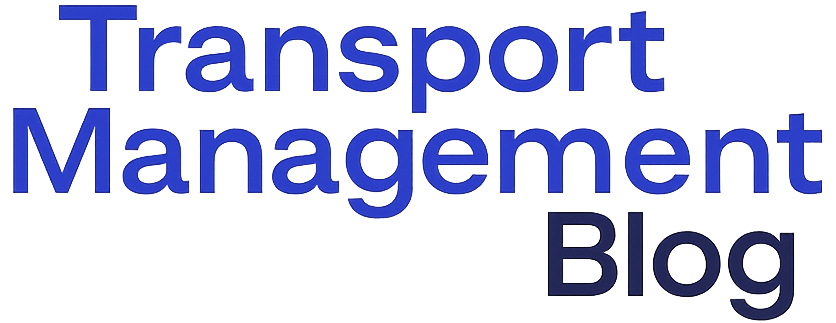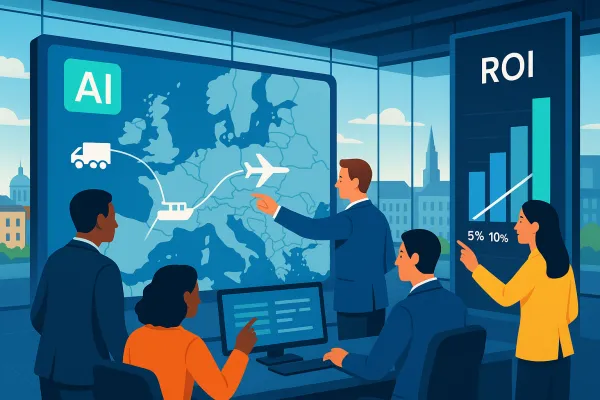The €4.5 Million TMS Security Risk: How European Shippers Can Build Bulletproof Vendor Cybersecurity Due Diligence to Prevent Operational Catastrophe

Last month, Knights of Old (KNP) Logistics Group collapsed entirely after a ransomware attack that began with a single weak password. The 158-year-old UK firm couldn't meet the £5-6 million ransom demand, forcing 700 employees out of work and disabling 500 trucks. The attackers encrypted everything—including backups and disaster recovery systems.
For European transport directors managing millions in annual logistics spend, this isn't just another cautionary tale. Advanced persistent threat detections targeting transportation and shipping rose 11% in Q1 2025, making it the second-most targeted sector after telecommunications. When your TMS cybersecurity vendor due diligence fails, the entire supply chain stops moving.
The financial stakes are brutal. The average data breach cost in the transportation sector hits $4.4 million, but operational collapse scenarios like KNP show potential losses in the tens of millions. Your transport management system security becomes your business continuity—there's no middle ground.
The €41 Million Problem: Understanding Your TMS Attack Surface
Most supply chain directors think about TMS platforms as logistics software. That's the first mistake. TMS relies heavily on data to manage and optimize transportation operations, from tracking shipments to managing inventory and scheduling deliveries. This data is vulnerable to cyber threats, such as hacking, malware, and phishing attacks, which can compromise the integrity of TMS data and operations.
Consider the modern freight dependency stack. Your TMS connects to:
- Carrier APIs for real-time tracking and rate shopping
- IoT telematics devices across your fleet or contracted vehicles
- EDI systems for customs documentation
- Customer portals displaying shipment visibility
- ERP integration for financial reconciliation
GPS trackers, telematics devices, and other IoT devices connected to the TMS can be entry points for attackers. These are often overlooked. Every unencrypted communication channel becomes a potential attack vector.
The math is sobering. Using ROSI calculations (Return on Security Investment), organizations with €50 million annual logistics spend face potential Annual Loss Expectancy of €2-5 million from TMS-related security incidents. ROSI = ([ALE x mitigation ratio] – cost of solution) / cost of solution. The calculation shows why vendor security matters more than price negotiations.
GDPR Article 28: The €20 Million Compliance Trap
European shippers face a regulatory minefield that amplifies TMS vendor risks. Article 28 requires controllers to use only processors providing sufficient guarantees to implement appropriate technical and organisational measures to meet GDPR requirements and ensure data subject protection.
Here's what transport directors miss: Article 28 states that controllers must ensure processors have "sufficient guarantees." If regulators don't believe the controller met Article 28 obligations, they can fine the controller for the same violation as the processor. Double liability exposure.
Your Data Processing Agreement must specify:
- Duration and scope of personal data processing
- Categories of data subjects (drivers, customers, employees)
- Processor security obligations and breach notification procedures
- Sub-processor authorization and oversight requirements
- Data deletion or return procedures after contract termination
GDPR fines can reach €20 million or 4% of global revenue—whichever is higher. For a €2 billion European manufacturer, that's €80 million maximum exposure. Powers have already issued $1.74 billion in GDPR penalties since January 2022.
The vendor evaluation becomes risk transfer. You need processors who demonstrate technical safeguards, not just contractual promises. Controllers must work only with processors who can produce evidence of their technical and organizational safeguards to ensure data integrity and meet GDPR requirements.
Building Your Bulletproof Vendor Due Diligence Framework
Most procurement teams evaluate TMS vendors on functionality and cost. Security assessment gets relegated to a checklist. Wrong approach for 2025 threat landscape.
Start with the fundamental question: Can a cloud-based provider do a better job securing your data than you can in-house? Transportation companies take 192 days on average to detect a breach and another 60 days to contain it.
Your vendor security assessment framework needs four layers:
Infrastructure Security Validation
Demand specifics, not marketing speak. What encryption standards for data at rest and in transit? Where are data centers located, and which compliance frameworks apply? Look for backups completed on defined schedules with copies replicated across high-speed secure circuits to dedicated disaster recovery centers. Backups should be stored on encrypted media with restricted access.
Application security matters equally. Secure code development and implementation across all systems and applications includes practices like prepared statements and SQL injection protection to prevent sophisticated attacks.
Access Control and Authentication
Two-factor authentication (2FA) adds an extra security layer by requiring users to provide two pieces of evidence to verify identity. By implementing 2FA, you significantly reduce the risk of unauthorized access to your TMS.
Role-based access control isn't negotiable. Your TMS vendor should demonstrate granular permissions management—finance teams see cost data, operations see tracking information, but no single user accesses everything without business justification.
Monitoring and Incident Response
Implementing robust monitoring and detection systems identifies and responds to potential security breaches in real-time. By proactively monitoring your TMS, you can swiftly respond to threats and minimize security breach impact.
The vendor's Security Operations Center capabilities determine your incident response speed. TMS vendors using cloud computing can leverage technologies and expertise to limit post-breach access.
Third-Party Risk Assessment
Your TMS vendor likely uses sub-processors for specialized functions—payment processing, mapping services, customs data validation. The processor cannot engage another processor without prior written authorization from the controller. For general authorization, the processor must inform the controller of changes concerning addition or replacement of processors.
Leading platforms like Cargoson, alongside established solutions such as SAP TM, Oracle Transportation Management, and Descartes, handle sub-processor management differently. Evaluate their vendor oversight processes, not just their direct security capabilities.
The ROI Reality: Making the Security Investment Business Case
Budget conversations change when you frame TMS cybersecurity vendor due diligence as loss avoidance rather than additional cost. Return on Security Investment (ROSI) quantifies how much loss an organization avoids through cybersecurity spending, making it possible to justify budgets and assess strategy effectiveness. Using quantitative risk analysis, ROSI factors in annualized loss expectancy, threat frequency, single incident cost, and mitigation ratio.
Calculate your Annual Loss Expectancy (ALE) for TMS-related incidents:
ALE = Annual Rate of Occurrence (ARO) × Single Loss Expectancy (SLE)
For a European manufacturer with €30 million annual transport spend:
- ARO for TMS-related security incident: 0.3 (based on industry data)
- SLE including operational downtime, data recovery, regulatory fines: €4.5 million
- ALE = 0.3 × €4.5 million = €1.35 million annually
Now factor in mitigation through proper vendor selection. Premium security-focused TMS solutions prevent 99% of common attack vectors, creating massive ROSI potential. If enhanced vendor security costs €200,000 annually but reduces ALE by 90%:
ROSI = (€1.35M × 0.9 - €200K) / €200K = 507%
That's €5.07 in loss avoidance for every €1 invested in rigorous vendor security evaluation.
Consider broader business continuity impact. "Computer systems today are so intrinsic in everything that a transportation company does to run its business that the business effectively cannot run without computers. They can't get a new load; they can't take an order from a shipper; they can't dispatch orders; they can't invoice for anything".
Continuous Monitoring: Your Vendor Oversight Strategy
Vendor due diligence doesn't end at contract signature. Software vulnerabilities are often exploited by cybercriminals to gain unauthorized access. By promptly applying security updates, you ensure your TMS remains protected against the latest threats.
Your ongoing vendor oversight program needs:
Regular Security Assessments
Processors must present detailed data mapping of their systems and measures to ensure GDPR compliance. They're expected to forward periodic audit reports, participate in inspections, and comply with independent audits run by controllers or appointed auditing bodies.
Quarterly security reviews aren't excessive for mission-critical TMS platforms. The vendor should provide penetration testing results, vulnerability scanning reports, and security incident summaries.
Performance Monitoring
Track security-related metrics alongside operational KPIs. Mean time to security patch deployment, incident response times, and security training completion rates for vendor staff tell the real story.
Leading solutions like E2open, Manhattan Active, and Alpega publish security dashboards for enterprise clients. Cargoson provides similar transparency, enabling proactive risk management rather than reactive damage control.
Zero Trust Implementation
Your TMS vendor architecture should assume breach scenarios. Proper network segmentation prevents breaches in one area from quickly spreading to others. Multi-factor authentication for all TMS access points becomes table stakes, not optional enhancement.
Future-Proofing Your Security Strategy for 2026 and Beyond
European regulatory landscape keeps evolving. NIS 2 Directive, Cyber Resilience Act, and DORA (Digital Operational Resilience Act for financial services) create new compliance requirements for transport operations.
The cybersecurity in logistics market was valued at $7.25 billion in 2023 and is projected to grow at over 10% CAGR through 2032. Investment follows threat escalation.
Post-quantum cryptography preparation separates forward-thinking vendors from those playing catch-up. Revolutionary technologies like connected and automated vehicles require new cybersecurity approaches. Your TMS vendor selection today determines your readiness for tomorrow's supply chain digitalization.
The vendor landscape splits into two categories: those building security-first architectures and those retrofitting protection. Platforms like Blue Yonder, nShift, and Transporeon take different approaches to quantum-readiness. Cargoson positions itself among vendors prioritizing next-generation security frameworks.
Maritime ransomware surged 467% year-on-year, and the average data breach in transport costs $4.18 million. These aren't distant threats—they're current operational realities shaping 2025 procurement decisions.
Your Next Actions: From Analysis to Implementation
Stop treating TMS cybersecurity vendor due diligence as compliance theater. Real-world examples like KNP Logistics show how single weak passwords lead to complete business collapse, forcing 700 employees jobless and disabling 500 trucks when companies can't meet ransom demands.
Start with your current vendor security assessment. Do they provide detailed security documentation, regular penetration testing results, and GDPR Article 28 compliance evidence? If not, your risk exposure may exceed your comfort level.
Calculate your specific ALE and ROSI numbers using your organization's transport spend and operational data. The €4.5 million average breach cost becomes your baseline for vendor security investment justification.
European transport operations can't afford security shortcuts in 2025. Your vendor due diligence framework determines whether your next security incident becomes a manageable business interruption or an operational catastrophe.





